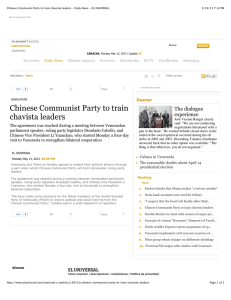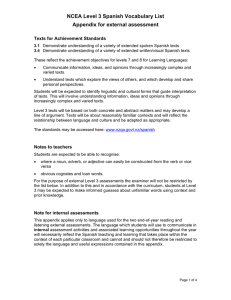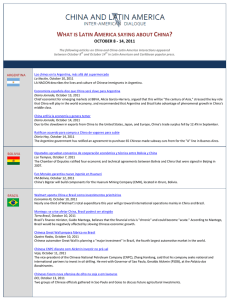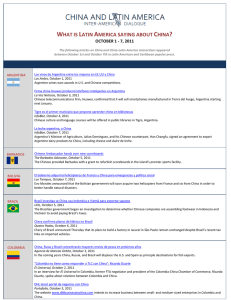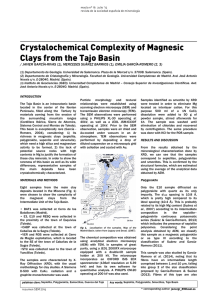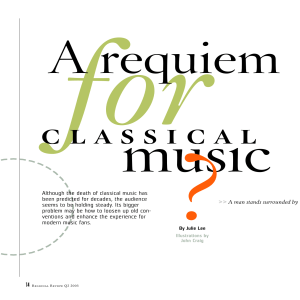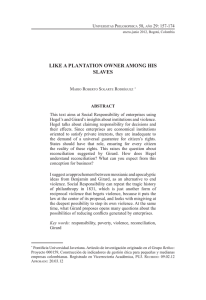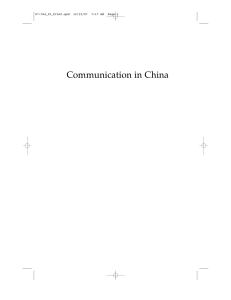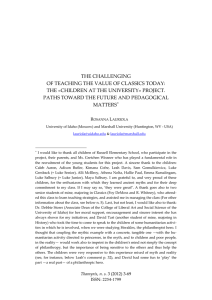Language VIb: Classical Chinese
Anuncio
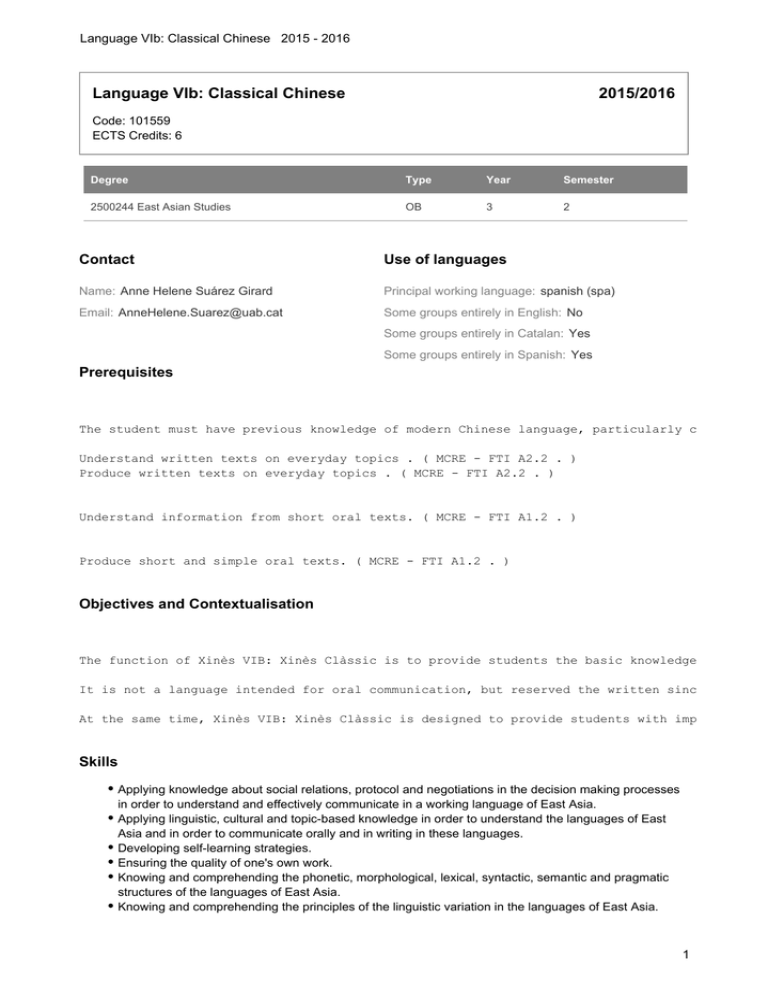
Language VIb: Classical Chinese 2015 - 2016 Language VIb: Classical Chinese 2015/2016 Code: 101559 ECTS Credits: 6 Degree Type Year Semester 2500244 East Asian Studies OB 3 2 Contact Use of languages Name: Anne Helene Suárez Girard Principal working language: spanish (spa) Email: [email protected] Some groups entirely in English: No Some groups entirely in Catalan: Yes Some groups entirely in Spanish: Yes Prerequisites The student must have previous knowledge of modern Chinese language, particularly concerning Understand written texts on everyday topics . ( MCRE - FTI A2.2 . ) Produce written texts on everyday topics . ( MCRE - FTI A2.2 . ) Understand information from short oral texts. ( MCRE - FTI A1.2 . ) Produce short and simple oral texts. ( MCRE - FTI A1.2 . ) Objectives and Contextualisation The function of Xinès VIB: Xinès Clàssic is to provide students the basic knowledge of classi It is not a language intended for oral communication, but reserved the written since the begi At the same time, Xinès VIB: Xinès Clàssic is designed to provide students with important kno Skills Applying knowledge about social relations, protocol and negotiations in the decision making processes in order to understand and effectively communicate in a working language of East Asia. Applying linguistic, cultural and topic-based knowledge in order to understand the languages of East Asia and in order to communicate orally and in writing in these languages. Developing self-learning strategies. Ensuring the quality of one's own work. Knowing and comprehending the phonetic, morphological, lexical, syntactic, semantic and pragmatic structures of the languages of East Asia. Knowing and comprehending the principles of the linguistic variation in the languages of East Asia. 1 Language VIb: Classical Chinese 2015 - 2016 Learning outcomes 1. Applying knowledge about social relations, protocol and negotiations in the decision making processes in order to understand and effectively communicate in a working language of East Asia. 2. Applying linguistic, cultural and topic-based knowledge in order to understand the languages of East Asia and in order to communicate orally and in writing in these languages. 3. Demonstrating knowledge about classical Chinese. 4. Developing self-learning strategies. 5. Ensuring the quality of one's own work. 6. Knowing and comprehending the phonetic, morphological, lexical, syntactic, semantic and pragmatic structures of the languages of East Asia. Content -Basic Knowledge about Chinese writing and Chinese classical language . -Writing conventions , lexical , morphosyntactic and textual differences . -Cultural, social and historical knowledge, helpful in learning classical Chinese language an Methodology We will work from original texts from Chinese literature: stories and fragments of history te Students will have the text in advance and must prepare on their own so that, in class, can r In class, the text sentence by sentence will be analyzed, highlighting the most important and The student must take notes of all these issues addressed in classe, as well as the usual voc Once worked the text, the student must translate on their own to the date indicated by the te The prior preparation of the texts and translating them once worked in class, must be for the Activities Title Hours ECTS Learning outcomes Analysis of texts in foreign languages 18.5 0.74 1, 2, 3 Comprehensive and analytical reading of texts in foreign language 19 0.76 1, 2, 3 Individual or group translation of texts in foreign language 18.5 0.74 1, 2, 3 problem solving and controlled exercises translation 13.5 0.54 1, 2, 3 Type: Directed Type: Supervised Type: Autonomous 2 Language VIb: Classical Chinese 2015 - 2016 Documentation search 17.5 0.7 1, 2, 3 Expansion of knowledge 15 0.6 1, 2, 3 Learning of vocabulary 15 0.6 1, 2, 3 Preparation of texts and translations 30 1.2 1, 2, 3 Evaluation The evaluation will be in two parts: A (40%) the form made in class activities. Assistance, the prior preparation of the texts as The other constitute two tests: a written, translation and vocabulary and syntax exercises th The review of the evidence will be in the opening hours of the teacher, in his office, on the Shall be deemed not submitted those who do not make at least the assessment tests equivalent In some special cases where the student has done a good tracking assignatura but obtained 4.5 In all other cases there is no recovery test. Evaluation activities Title Weighting Hours ECTS Learning outcomes Classroom activities (attendance , reading, participation , translation, analysis) 40 1 0.04 1, 2, 6, 3, 4, 5 Oral test 25 1 0.04 1, 2, 3 Written test 35 1 0.04 1, 2, 3 Bibliography Chen Qiyou: Hanfeizi jishi, Shanghai, Renmin chubanshe. Raymond Dawson, A New Introduction to Classical Chinese. Oxford: Clarendon, 1986. Michael A. Fuller, An Introduction to Literary Chinese. Cambridge: Harvard University Press, 1999. Robert H. Gassmann, Grundstrukturen der antikchinesischen Syntax. New York: Peter Lang, 1997. Robert H. Gassmann, Antikchinesisch in fünf Element(ar)gängen : eine propädeutische Einführung. Bern ; New York : Peter Lang, 1997. Robert H. Gassmann and Wolfgang Behr, Antikchinesisch: Ein Lehrbuch in drei Teilen. Bern; New York: Peter Lang, 2005. Jean Levi: Han-fei-tse ou Le Tao du Prince, Seuil, Paris, 1999. 3 Language VIb: Classical Chinese 2015 - 2016 Naiying Yuan, Haitao Tang and James Geiss, Classical Chinese: Introduction to Grammar; A Basic reader in Three Volumes. Princeton: Princeton University Press, 2004. Paul Rouzer, A New Practical Primer of Literary Chinese. Cambridge, Mass.: Harvard University Asia Center, 2007. Edwin G. Pulleyblank, Outline of Classical Chinese Grammar. Vancouver: UBC Press, 1995 (repr. 1996) Harold Shadick, A First Course in Literary Chinese. 3 vols. Cornell University Press, 1968. Anne-Hélène Suárez Girard: A punto de partir. 100 poemas de Li Bai, Pre-Textos, Valencia 2005. Anne-Hélène Suárez Girard: Lun yu, reflexiones y enseñanzas, de Confucio, edición y traducción, Kairós, Barcelona, 1997. Anne-Hélène Suárez Girard: Libro del curso y de la virtud (Dao de jing), de Lao zi, edición y traducción (prólogo de François Jullien), Siruela, colección El árbol del paraíso, Madrid, 1998. Reeditado en 2003 como Tao te king. Anne-Hélène Suárez Girard: 99 cuartetos de Wang Wei y su círculo, edición y traducción, colección Cruz del Sur, Pre-textos, Valencia, 2000. Anne-Hélène Suárez Girard: 111 cuartetos de Bai Juyi, edición y traducción, colección Cruz del Sur, Pre-textos, Valencia, 2003. Anne-Hélène Suárez Girard: "Poesia Clásica Xinesa" en Literatura xinesa, UOC, Barcelona 2004. Tang Jingzhao; Li Shi'an: Hanfeizi jiaozhu, Renmin chubanshe, 1982. Diccionarios Hanyu da zidian . Wuhan: Hubei cishu chubanshe and Sichuan cishu chubanshe, 1986. Gu Hanyu chang yong zi zidian (Shanghai: Shangwu yinshuguan, 1998, repr. 2001). Ci yuan . Edited by Lu Erkui et al. Beijing: Shangwu yinshuguan, 1979, 4 vols. Chen Fuhua . Gudai Hanyu cidian . Beijing: Shangwu yinshuguan, 2000. Bernhard Karlgren, Grammata Serica Recensa. Stockholm: Bulletin of the Museum for Eastern Antiquities, 1957. Schuessler, Axel. Minimal Old Chinese and Later Han Chinese. A Companion to Grammata Serica Recensa. Honolulu: University of Hawai'i Press, 2009. Dictionnaire Ricci des Caractères Singuliers. Taipei: Ricci Institute, 1999. Grand dictionnaire Ricci de la langue chinoise , 6 vols. Taipei: Institut Ricci, 1999. 4


